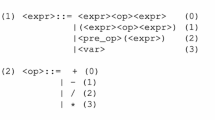Abstract
This study examines Social Programming, that is, the construction of programs using a Social Swarm algorithm based on Particle Swarm Optimization. Each individual particle represents choices of program construction rules, where these rules are specified using a Backus–Naur Form grammar. This study represents the first instance of a Particle Swarm Algorithm being used to generate programs. A selection of benchmark problems from the field of Genetic Programming are tackled and performance is compared to Grammatical Evolution. The results demonstrate that it is possible to successfully generate programs using the Grammatical Swarm technique. An analysis of the Grammatical Swarm approach is presented on the dynamics of the search. It is found that restricting the search to the generation of complete programs, or with the use of a ratchet constraint forcing individuals to move only if a fitness improvement has been found, can have detrimental consequences for the swarms performance and dynamics.
Similar content being viewed by others
Explore related subjects
Discover the latest articles, news and stories from top researchers in related subjects.References
Banzhaf W, Nordin P, Keller RE, Francone FD (1998). Genetic Programming – An Introduction; On the Automatic Evolution of Computer Programs and its Applications. Morgan Kaufmann, San Mateo, California
Bonabeau E, Dorigo M, Theraulaz G (1999). Swarm Intelligence: From natural to artificial systems. Oxford University Press, Oxford
Brabazon A, O’Neill M (2006). Biologically Inspired Algorithms for Financial Modelling. Springer, Berlin
Brabazon A, Silva A, de Sousa TF, ONeill M, Matthews R, Costa E (2005) Investigating Strategic inertia using OrgSwarm. Informatica 29:125–141
Kennedy J, Eberhart R, Shi Y (2001). Swarm Intelligence. Morgan Kauff-man, San Mateo, California
Kennedy J and Eberhart R (1995) Particle swarm optimization, Proceedings of the IEEE International Conference on Neural Networks, December 1995, pp. 1942–1948, IEEE Press
Koza JR (1992) Genetic Programming. MIT Press
Koza JR (1994) Genetic Programming II: Automatic Discovery of Reusable Programs. MIT Press
Koza JR, Andre D, Bennett FH III, Keane M (1999). Genetic Programming 3: Darwinian Invention and Problem Solving. Morgan Kaufmann, San Mateo, California
Koza JR, Keane M, Streeter MJ, Mydlowec W, Yu J, Lanza G (2003) Genetic Programming IV: Routine Human-Competitive Machine Intelligence. Kluwer Academic Publishers
Langdon WB and Poli R (1998) Why ants are hard. In: Genetic Programming 1998: Proceedings of the Third Annual Conference. University of Wisconsin, Madison, Wisconsin, USA, pp. 193–201, Morgan Kaufmann, San Mateo, California
O’Neill M and Brabazon A (2004) Grammatical Swarm. In: LNCS 3102 Proceedings of the Genetic and Evolutionary Computation Conference GECCO 2004. Seattle, WA, USA, pp. 163–174, Springer, Berlin
O’Neill M and Ryan C (2003) Grammatical Evolution: Evolutionary Automatic Programming in an Arbitrary Language. Kluwer Academic Publishers
O’Neill M (2001) Automatic Programming in an Arbitrary Language: Evolving Programs in Grammatical Evolution. PhD thesis, University of Limerick
O’Neill M, Ryan C (2001). Grammatical Evolution. IEEE Transactions on Evolutionary Computation 5(4):349–358
O’Neill M, Ryan C, Keijzer M, Cattolico M (2003). Crossover in grammatical evolution. Genetic Programming and Evolvable Machines 4(1):67–93
Ryan C, Collins JJ, O’Neill M (1998) Grammatical evolution: evolving programs for an arbitrary language. Proceedings of the First European Workshop on GP. pp. 83–95, Springer-Verlag, Berlin
Silva A, Neves A, Costa E (2002) An empirical comparison of particle swarm and predator prey optimisation. In: LNAI 2464, Artificial Intelligence and Cognitive Science, the 13th Irish Conference AICS 2002. pp. 103–110, Limerick, Ireland, Springer, Berlin
Author information
Authors and Affiliations
Corresponding author
Rights and permissions
About this article
Cite this article
O’Neill, M., Brabazon, A. Grammatical Swarm: The generation of programs by social programming. Nat Comput 5, 443–462 (2006). https://doi.org/10.1007/s11047-006-9007-7
Received:
Accepted:
Published:
Issue Date:
DOI: https://doi.org/10.1007/s11047-006-9007-7




